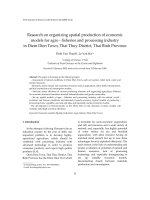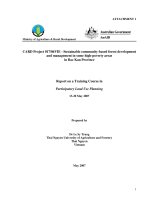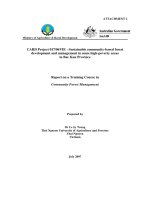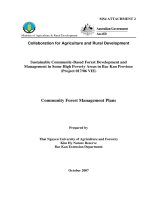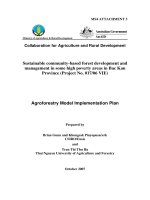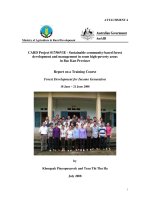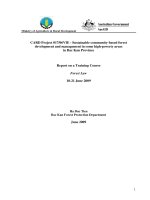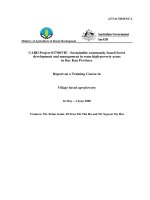Reseach on building models of community - based tourism (the case of Giang Mo Village, Cao Phong district, Hoa Binh province
Bạn đang xem bản rút gọn của tài liệu. Xem và tải ngay bản đầy đủ của tài liệu tại đây (797.15 KB, 100 trang )
VIETNAM NATIONAL UNIVERSITY, HANOI
INSTITUTE OF VIETNAMESE STUDIES AND DEVELOPMENT SCIENCES
DANG HOANG GIANG
RESEARCH ON BUILDING MODELS OF
COMMUNITY- BASED TOURISM
(CASE STUDY OF GIANG MO VILLAGE, CAO PHONG
DISTRICT, HOA BINH PROVINCE)
MASTER THESIS
Speciality: Vietnamese Studies
Hanoi, 2011
VIETNAM NATIONAL UNIVERSITY, HANOI
INSTITUTE OF VIETNAMESE STUDIES AND DEVELOPMENT SCIENCES
DANG HOANG GIANG
RESEARCH ON BUILDING MODELS OF
COMMUNITY- BASED TOURISM
(CASE STUDY OF GIANG MO VILLAGE, CAO PHONG
DISTRICT, HOA BINH PROVINCE)
MASTER THESIS
Speciality: Vietnamese Studies
Code: 60.31.60
Supervisor: Dr. LE ANH TUAN
Hanoi, 2011
1
CONTENTS
INTRODUCTION 5
1. Reason for theme 5
2. Aims and objectives 6
3. History of the research problem 7
4. Subject and scope of the research 8
5. Research Methodology 8
6. The layout of the thesis 9
Chapter 1: THEORITIACL AND PRACTICAL FRAMEWORK OF
COMMUNITY - BASED TOURISM 10
1.1. History and opinions of the formation of community - based tourism 10
1.1.1. History of the formation of community - based tourism 10
1.1.2. Opinions of community - based tourism 11
1.2. Conditions and principles of community tourism development 13
1.2.1. Conditions of community - based tourism development 13
1.2.1.1. Tourism resources 14
1.2.1.2. Material and technical facilities 15
1.2.1.3. Transportation 16
1.2.1.4. Support service for tourism 16
1.2.1.5. The preparation of community 17
1.2.2. Principles of community - based tourism development 18
1.2.2.3. Tourism activities decided by local community 20
1.2.2.4. Preserving resources 20
1.3. Role of community - based tourism development 21
1.3.1. The role of community - based tourism for local community 21
1.3.2. The role of community - based tourism for local economy 21
1.3.3. The role of community - based tourism for resource conservation 22
1.4. Some of experiences in developing community - based tourism model 22
1.4.1. In the world 22
1.4.2. In Viet Nam 26
1.4.2.1. Models of community - based tourism in Sin Chai village, Sa Pa
district, Lao Cai province 27
2
1.4.2.2. Models of community - based tourism in Doi village, Namdong
district, Thua Thien Hue province 30
1.5. Conclusion of chapter 1 33
Chapter 2: CURENT SITUATION OF THE COMMUNITY-BASED
TOURISM OPERATE AND DEVELOPMENT IN HOA BINH
PROVINCE 34
2.1. Tourism potentiality of Hoa Binh province 34
2.1.1. Natural tourism resources 35
2.1.2. Human tourism resources 36
2.2. Models of community - based tourism in Lac village, Maichau district . 37
2.2.1. The formation and development of community - based tourism in
Mai Chau 37
2.2.2. Characteristics of community - based tourism model in the Lac, Mai
Chau district 39
2.2.2.1. The role of community 39
2.2.2.2. Types of products 40
2.2.2.3. Characteristics of tourists 41
2.2.2.4. Cooperation mechanisms and sharing related benefit 42
2.2.3. The advantages of community - based tourism to economy,
society and culture 45
2.2.3.1. Positive impacts 45
2.2.3.2. Negative impacts 47
2.2.4. Evaluation of community-based tourism model in the Lac village,
Mai Chau district 48
2.2.4.1. Strengths 48
2.2.4.2. Limitations and causes 49
2.2.4.3. The lessons experience 50
2.3. Characteristics of community – based tourism in Cao Phong district,
Hoa Binh province 51
2.3.1. Overview of Cao Phong district 51
2.3.1.1. Geographic features 51
2.3.1.2. Administrative boundaries 51
2.3.1.3. Economic development of Cao Phong district 52
3
2.3.2. Tourism potentiality of Cao Phong 54
2.3.2.1. The basic values 54
2.3.2.2. Conditions of infrastructure and technical facilities 56
2.3.3. Reality of tourism development in the Giang Mo village, Cao
Phong district 57
2.3.3.1. Overvew of the Giang Mo village 57
2.3.3.2. The result of tourism activities 59
2.3.3.3. Local communities with tourism activities 62
2.3.3.4. Other characteristics 62
2.3.4. Evaluation of the activities of tourism development in the Giang Mo,
Cao Phong district 64
2.3.4.1. Strengths 64
2.3.4.2. Limitations and causes 65
2.4. Compare models of tourism development in Ban Lac, Mai Chau
district with Giang Mo village, Cao Phong district 66
2.4.1. The same 66
2.4.2. The different 67
2.5. Conclusion chapter 2 72
Chapter 3: DETERMINATION OF BUIDING MODELS OF
COMMUNITY - BASED TOURISM IN CAO PHONG DISTRICT,
HOA BINH PROVINCE 74
3.1. Determine of tourism development of Hoa Binh Province 74
3.1.1. Aim of tourism development 74
3.1.2. Tasks 75
3.2. Orientation for tourism development of Cao Phong district 76
3.3. Determine building community - based tourism model in the Giang
Mo village, Cao Phong district 78
3.4. Put forward community - based tourism development model in
Giang Mo village, Cao Phong district 79
3.4.1. Basis of the proposals 79
3.4.2. Principles to develope community - based tourism model in Giang
Mo village, Cao Phong district 82
4
3.4.3. Content of model 84
3.4.3.1. Defining the role of community 84
3.4.3.2. Determine the role of management 85
3.4.3.3. Determine the role of tourism companies 85
3.4.3.4. Building community mechanism in the benefit sharing between subjects 85
3.4.3.5. Identify types of products and services 86
3.4.4. The conditions to establish the model 87
3.4.4.1. The policy of authorities 87
3.4.4.2. The availability of community 88
3.4.4.3. Knowledge of people 88
3.4.4.4. Infrastructure, facilities upgraded and other essential conditions 88
3.5. Applying the model for Cao Phong 89
3.6. Some recommendations 90
3.6.1. Recommendations to the State management agency on tourism 90
3.6.2. Recommendations to the provincial People's Committee of Hoa Binh
and People's Committee of Cao Phong district 90
3.6.3. Recommendations for the People's Committee of Binh Thanh commune91
3.6.4. Recommended for local people 92
REFERENCES 96
5
INTRODUCTION
1. Reason for theme
Nowadays, tourism has become a necessity of life. It is not only a key
economy of nations but also a bridge of cultural exchanges among nations
and areas in the world.
Recently, the tendency of visiting remote mountainous regions, where
ethnic minorities live, becomes very popular, especially as for foreign tourists
and the youth because of wild natural landscapes and original cultural traits.
Consequently, another from of tourism has been development, known as
community - based tourism.
Community - based tourism is one of very attractive tourism types. It
has brought in many benefits of economy and society to communities in the
world. In Viet Nam, this type has been researched and put into practice in
many locals. Such as: Mai Chau (Hoa Binh), Ba Be (Bac Can), Sa Pa (Lao
Cai), Suoi Voi (Hue)…ete. However, there is not special research on the
manner of developing community – based tourism for each area. Community
– based tourism activities in these areas do not rely on the result of scientific
research that relies on experience. Therefore, we need research reality and
learn from experience in order to orient the development of community –
based tourism in Viet Nam.
Community – based tourism in Hoa Binh has been developed for a long
time. The most typical is community – based tourism model in Mai Chau. The
tourism operations in Mai Chau relies exploring culture tradition of Thai
ethnic. During the tourism activities develop has been an inadequate problem
such as adverse effect on culture tradition of local, pollution of
environment…etc.
6
The same Mai Chau, Cao Phong district, Hoa Binh province, has many
tourism resources. Among them community - based tourism relies on
exploring culture of ethnic minorities in Giang Mo - the most typical village.
This is the main residential area of Muong people (one of the four major area
of Muong) with traditional cultural values. The tourism activities at Giang Mo
has been beginning and developing since 1980s. Giang Mo village has
become an attractive destination. However, the tourism operation there has
not been managed effectively to meet its potentials. Thus, in the current
tourism tendency, studying and expanding the community - based tourism in
Giang Mo are very important.
In order to improve tourism operations in Cao Phong, it’s necessary to
study tourism potentiality as well as reality of the district. From that, we can
design and build the suitable model. For these reasons, the researcher decided
to carry out an investigation into the issue titled: “Research on building
models of community - based tourism (Case study of Giang Mo village, Cao
Phong district, Hoa Binh province)”.
2. Aims and objectives
Aims: orientate to building community - based tourism model in Cao
Phong district, Hoa Binh
Objectives:
- To systematize theoretical issues about community - based tourism
- To analyze experience in developing community tourism in Maichau
and some other locals in Viet Nam
- To analyze evaluate developing community tourism in Cao Phong
- To compare model community - based tourism of Lac village to
bring out community based model in Cao Phong
7
3. History of the research problem
There were a great number of scientific studies on community -
based tourism such as:
“Community - based tourism for Conservation and Development”
book published in 2003 by The Mountain Institute (America). The authors
have given concept, role and motivation factors of community tourism. The
authors have also presented some of community tourism models in the South
America and Malaysia. Then, they presented knowledge, skills and
experiences about community tourism.
“Community - based tourism – theory and use” (volume 1) book, PhD.
Vo Que (2006). The author presented community based tourism theory
(concept, aim, condition, signification, principle and criterion of community
based tourism). Beside, the author also researched some community based
tourism models in Asia and Viet Nam. However, he did not present concrete
conditions and model.
"Sustainable tourism" book was published in 2001 of Nguyen Dinh Hoe
and Vu Van Hieu. The researchers thought that local community is an important
in development of community based tourism. However, they did not concern with
factors of community based tourism for localities in Viet Nam.
"Tourism with problems of ethnic minorities in Sa Pa" book was
published in 2000 of Pham Thi Mong Hoa and Lam Thi Mai Lan. The
researchers presented the influence of tourism on local ethnics in Sapa
district, Laocai province. Throughout, the researchers put forward solutions to
minimize negative impact and enhance benefits for local communities in
tourism activities.
PhD Pham Le Thao’s “To organize the territory of Hoa Binh in opinion
of sustainable development” (2006). The author analyzed, evaluated and
8
synthesized the factors of Hoa Binh’s arrangement and development. In
thesis, the author mentioned the development of community based tourism in
Giang Mo.
MA Nguyen Thi Hong Van’s “The effect of tourism on cultural –
society of Thai ethnic in Maichau district, Hoa Binh province and
development solutions” thesis (2007). The researcher studied the influence of
tourism on Thai people’s economy, cultural, society in Mai Chau. Since then,
the author put forward the orientation sustainable development for community
based tourism in Mai Chau.
4. Subject and scope of the research
- Subject of research: community - based tourism form and
development conditions of community - based tourism.
- Scope of content: community relies on exploiting ethnic minorities’ culture.
- Scope of space: Cao Phong district, with the Giang Mo village is
focused to research Maichau district, with Lac village is comparison subjects.
- Scope of time: information and data collected from 2005 to 2010.
5. Research Methodology
Researcher used 6 methods of scientific research: Researching
synthesis theory, comparative approach, methods of sociological
investigation, observation, questionnaire method, methods of analysis and
synthesis.
Research resources:
- Books and textbooks
- Newspapers, journals and magazines related content
- The scientific work such as reports, theses
- Report of the local governments and state agencies on tourism.
- Information and articles on the internet.
9
6. The layout of the thesis
Besides the introduction, conclusion, addendums, references, the thesis
includes three chapters as followings:
Chapter 1: Theoretical basis and reality of community - based
tourism
Chapter 1 presents theoretical basics, concepts of community - based
tourism, principles and conditions of community - based tourism.
Concurrently, chapter 1 also provides some experience about community -
based tourism in Viet Nam and other countries.
Chapter 2: Current situation of the community-based tourism
development operations in Hoa Binh prefecture
Chapter 2 presents the conditions for tourism development in Hoa
Binh. The chapter also introduces community - based tourism model in Lac
village, Maichau district. The conditions and reality of development tourism
operation in Giang Mo village include: the conditions about natural resources,
local residents, infrastructure and technical material, the policies and support.
The researcher assesses advantages and disadvantages of community - based
tourism model in Lac village. Thenceforth, the researcher orients of building
community - based tourism in Giang Mo village.
Chapter 3: Orientation of building models of community - based
tourism in Cao Phong district, Hoa Binh province
Chapter 3 presents tourism development orients Hoa Binh province and
Cao Phong district, puts forward solution development, determines model and
gives some petitions in order to exploit the conditions to develop community -
based tourism in Cao Phong.
10
Chapter 1: THEORITIACL AND PRACTICAL FRAMEWORK
OF COMMUNITY - BASED TOURISM
1.1. History and opinions of the formation of community - based tourism
1.1.1. History of the formation of community - based tourism
Community is relationship between personal, which is decided by the
similar in living conditions and activities of personal in there. It concludes the
production activities, the similar in religious beliefs, social value system,
living conditions and operational targets.
Community - based tourism (CBT) was derived from tourism village
operations in 1970s. Visitors went on walking around village, discovered
customs and culture, daily life, festivals of local residents or certain travelers
to participate in ecotourism activities. Normally, this tourism activity is hold
in natural wild area or a diverse ecosystem but also remote and sparsely
populated. When participating in this tourism type, the visitors are able to
meet with difficulties about: traffic, living conditions, and information and
support tourism conditions. The tourists need help from local people such as
guidance, food, accommodate…etc. Therefore, they called it “the trip has the
support of local people”. That is the premise for the concept of community
tourism development and community - based tourism.
After a period of time, governments and social organizations have
recognized that the community – based tourism activities brought about many
adverse effects for economy, cultural, politics and social in there. The factors
to attractive tourists are the tourism services and the culture traditional of
local people. Therefore, living standards gradually improve when the tourism
activities developed.
Relying on the tourism activities, local residents are more aware of
preserving cultural identity and their habitats. If not visitors, living of local
people only depend on exploring natural resources. Hence, natural resources
11
will become exhausted. However, the tourism activities are developed local
residents has opportunities to heighten themselves awareness of preserve value of
resources. The more tourism resources preserves, the more attractive visitors and
the more increasing income. Like this, local people take part in the tourism
activities will preserves resources while improving living standards.
Community – based tourism was gradually established and generally
expanded in many regions on the world. Community - based tourism began to
develop in Africa, Australia, and America in 1980s and 1990s with the help of
NGOs and IUCN. Community - based tourism began to develop straightly in
Asia concluding ASEAN countries.
The community – based tourism vocabulary has been widely used
ASEAN countries in 5 months 1995 years since “Building a framework for
developing community – based tourism” conference in Indonesia and
Philippines. At the conference, many reports are given different opinions,
concepts, modes, conditions and how to build as well as summaries
experiences about organization model of community – based tourism. Then
these conferences, both theoretical and practical about model community –
based tourism were studied by the countries in region. The theories of
community – based tourism were gradually formed. Through out many
models, the concepts, aims, criterions and conditions for growth community –
based tourism were provided.
1.1.2. Opinions of community - based tourism
The researcher introduces different concepts of scientists around the
world and conceptualizes community tourism in the scope of the thesis.
Community – based tourism has been exited since 1970s. According to
the way of deference approach so have many opinions about it.
The opinions of experts in community – based tourism are: developing
tourism relies on community is the form of promoting ethnic minority people
12
participate in discussion related issues, community also benefit from tourism
activities. Thanks to community – based tourism, the living standard of ethnic
minority people was raised.
The Nicole Hausle and Wolffgang Strasdas (2000) researcher thought
that: community – based tourism is the form tourism those residential locals
come forward and organize and administer. The profit from tourism economy
will retained local economics.
Some of researcher has a high opinion of community – based tourism
as well as ecotourism and sustainable tourism. The report of “The application
community – based tourism of Butrin national park, South Albania” (2006),
Ph.D. Klodianna Gorica (Tirana University, Albania) thought that:
community – based tourism is the cleverer than sustainable tourism.
Community – based tourism be able to effect on residential locals about:
providing works, creating income, supporting cultural, preserving
environment. The local people have an initiative power for activities tourism.
Especially, community – based tourism is solution of destination
management. The aim of community – based tourism is preserve resources
nation and local cultural. Hence, the local people and visitors are enjoyed
from tourism economy.
“The business method in community – based tourism in developing
countries” report of Robert M. Davison, Roger W. Harris and Douglas Rvogel
(City University of Hong Kong) thought that: community - based tourism is
solution for the development of community and the conservation of resources
natural and humanity. Community – based tourism is close relationship with
ecotourism. Community – based tourism not only contributes to conservation
of resource but also raise the living standards of local people. Community –
based tourism has been carried out in developing countries with activities
13
such as helpfulness of wildlife management, conservation of environment,
development of human and culture local.
Mountain Institute in The State of West Virginia (America) gave a
community – based tourism concept: community – based tourism is tourism
activities with the arm conservation tourism resources for the sustainable
development. Community – based tourism encourage local people take in part
of tourism activities with the common mechanism to create opportunities for
the community.
Community – based tourism is a process of the interaction between
communities with visitors. The participation of both will bring economic
benefit, preservation of community and environment local.
From the opinions and concepts about community – based
tourism on forgoing, the concept of community - based tourism within the
scope of this thesis is understood as follows:
Community - based tourism develops sustainable regional community
in which the subject is directly involved in tourism activities. Regional
community providing travel services while conserving the culture resources,
natural resources and environment. Concurrently, regional community benefit
materially and spiritually from tourism and conservation achievements that”.
1.2. Conditions and principles of community tourism development
1.2.1. Conditions of community - based tourism development
To develop community - based tourism, it is necessary to ensure these
conditions: tourism resources, material facilities, and support services for
tourism, transport, participation of community and policy of local authorities,
which influence the formation and development of community tourism.
Among them, the tourism resources and participation of local community
are extraordinarily important.
14
1.2.1.1. Tourism resources
Tourism resources are the natural landscape, natural elements,
historical – cultural vestiges and the work of humans’ create labor and
other human values can be used to meet the needs of tourism, is
fundamental factor to the formation of tourist area, destinations, tours and
tourist urban.
Tourism resources including natural tourism resources and human
tourism resources are being exploited and unexploited.
Natural tourism resources including geology, topography,
geomorphology, climate, hydrology, ecosystems, and natural landscapes can
be used for tourism purposes.
Human tourism resources including a total value of material and
spiritual of man were created during impact on natural and social, including
myself over the course of history. Human tourism resources are divided into
many groups such as: historical – cultural vestiges, festivals, the
objects associated with ethnography (house, culture traditional…etc),
manners and customs, clothes traditional…etc.
Tourism resources are prerequisites for the formation and development
of various types of tourism in general and community – based tourism in
particular. Tourism resources are determining factor to create the value of the
destination. Destinations the more rich in tourism resources, the more unique
and attraction to tourists, promote tourism in the region. Tourism product is
created by many factors, but we must first mention of tourism resources. To
meet the demands of tourists, the tourism product must not monotonous, poor,
unattractive. It must rich, diverse, distinctive and fresh.
For community - based tourism, tourism resources as rich and unique
conditions, the more powerful and sustainable development.
15
1.2.1.2. Material and technical facilities
Material and technical facilities have an important in the process of
creation and performance tourism produces as well as decision how to exploit
tourism resources in order to satisfy the needs of visitor. Besides, material and
technical facilities also have bad or good influence on psychology of traveler
when traveling. Therefore, those are one of the important factors contributing
to effective tourism.
Hence, the development of the tourism industry is always associated
with building and improving material and technical facilities.
The material and technical facilities of tourism including the construction
and means with the function to create services that meet the needs of tourists, such
as transport, accommodation, meals, sightseeing, entertainment etc. It also
decides the quality of tourism services and the value of tourism products in
general and the community based tourism in particular.
- The transport: the local transport includes the automobiles,
motorcycles, bicycles, boats, vehicles using animal can be able to move the
tourists during the tour. All transport should make sure that safety, hygiene
and quality.
- The accommodation: the accommodation includes hotels, motels,
private house etc. These accommodations belong to the administration of
residential local. All accommodations needs guarantee quality, hygiene with
equipment for essential needs of tourists. Especially, the toilets must be
equipped with appliances such as: water heaters, bathroom
- The meals: the meals are essential needs of tourists. It also benefits
local people. The meals good will impulse the development of community –
based tourism. The food area needs ensure hygiene, safety and comfort. The
food variety with local specialties but must ensure hygiene standards and
suitable to the taste of tourists.
16
- Other Equipments: Include specific equipments for the purpose of the
trip or specific tourism activities. The means must be equipped suitable to
satisfy the needs of visitor.
We want to exploit effectively tourism resources system require
material facilities good. According to the above characteristics, we can
understand the material and technical facilities include all of the material
means serve traveler’s needs.
1.2.1.3. Transportation
Transportation is one of the first – rate important factor. Tourism
associates with the moving of people over a region. This depends closely on
transportation. The destination can be attractive for traveler, but still can not
exploit without transport factors. If the convenient transportation system,
tourism operations will quickly became a common phenomenon in society.
Each traffic type has distinct characteristics. Road traffic allows guests
to easily follow the route chosen. Railway traffic is cheaper than road traffic
but only follow fixed routes. Air traffic is quicker, shortening the travel time,
but more expensive. Waterway is slower but can be sightseeing and
entertainment along the river or the sea.
1.2.1.4. Support service for tourism
Communication is an important part of infrastructure for tourism. It is a
necessary condition to ensure the exchange of tourists. In tourism operations,
the communication provides information quickly and in time as well as the
exchange between the regions in the country and international.
The electricity, water, village hospital in destinations are indispensable. The
visitors move from regular residence to other places. Hence, they also need
ensured essential needs.
17
1.2.1.5. The preparation of community
Community is one of the important elements that make up the type of
community - based tourism. Therefore, the level of participation of the community
has an important in the existence and development of community - based tourism.
Community residents include only the local people, whose are living in or
beside areas of tourism resources, does not include people or businesses from
other areas to work or business.
Local community provides services to develop community – based
tourism. Concurrently, they also conserve nature resources, environment and
culture traditional of community. Community is direct subject of operations
tourism. They decide the existence and growth of community – based
tourism. Local community provides services tourism while controlling
tourism resources.
The involvement of local communities in tourism development is
expressed through:
- The awareness of conservation tourism resources: The local
community is the subject of community – based tourism type. Business
tourism activities depend on community is the participation, management and
conservation tourism resources in their habitation. Thus, they should be
responsible for the conservation of natural resources, environment and local
culture. They must understand their interests in the conservation of these
resources.
- The awareness of tourism: the local community to be aware of the
benefits of economic and social from tourism activities. They should welcome
tourists warmly. If they to be shy of the impact of tourists on their lives or
self-conscious about their life, it will make difficulties in community – based
tourism development. Also, local communities must be aware of the
seriousness of tourism activities. Their services must be high quality to meet
18
the needs of the tourists to reach economic efficiency. They should not try to
earn money from tourists with all forms of tourism that depressed.
- The knowledge about culture – society: local community must to
understand the values of local cultural. They need find out customs and
information of local, furthermore they need knowledge of psychology and
demand of tourists.
1.2.1.6. The policy of local authorities
The policy of local authorities is an impulse the development of
tourism operations. If the policy is advantageous, it will create favorable
conditions for tourism activities development. Conversely, if the local
authorities do not support and make difficulties, operations tourism will not
develop. The local authorities can support tourism development by: creating
favorable conditions for tourists to visit, encouraging and support local
communities join in tourism activities, orienting and controlling tourism
activities in local communities, ensuring the security in local, creating images
for their locality as a safe destination for tourists, building the tourism
infrastructure. Also, local authorities have an incentives policy to encourage
business organizations to invest in tourism development.
1.2.2. Principles of community - based tourism development
Some principles in order to develop community - based tourism are:
relying on local community, allocating profit reasonably, tourism activities
decided by local community, preserving resources.
1.2.2.1. Relying on local community
Characteristic of community-based tourism is a relying on local
community. In particular, the local community is the subject of tourism
activities. They participate in all processes of tourism such as: organizing
activities tourism, providing the services tourism, conserving traditional
cultural values in order to meet the needs of the tourists Therefore, the first
19
principle of community-based tourism activities is the relying on local
community. We can not develop community – based tourism without relying
on the local community.
The community tourism programs must be built on the ability of local
community. It includes the competence for their role and position in the use
of resources and the role of tourism for the development of local community,
the disadvantages of tourism activities and visitors for the development for
the local community, human and financial resources to meet the requirements
of tourism development. Beside, we also need assess the attractiveness and
originality of the traditional cultural values of local communities in tourism
development.
1.2.2.2. Allocating profit reasonably
Allocating profit reasonably is one of the conditions to community –
based tourism sustainable development. Production of community – based
tourism is the result of relationship between local communities, local
authorities with business tourism.
Local communities are responsible for providing tourist services,
organizing tourist activities and ensuring the tourism resources. They are
directly involved in tourism activities in the community.
The local authorities directly control the administrative formalities
about tourism activities, ensure order and security for community and visitor
and make local a safe destination for tourists.
Tourism businesses include business travels and companies providing
tourism services. Business travel is a bridge-between tourists and tourism
resources in the region as well as tourism services offered by local
communities living there. Business travel is an important factor in the
development of the tourism market. Community - based tourism will be
difficulty develop without the participation of business travels.
20
With the principle, the participants are benefited the same. The source
of income from the tourism business is divided to all participants. This benefit
is also shared by taxpayers to the overall development of society.
1.2.2.3. Tourism activities decided by local community
The condition for the formation of community tourism is community.
All tourism activities of community – based tourism are formed on the ability
of the community. Therefore, communities should be entitled to participate in
discussions tourism plans. In some cases, it can give ownership to the
community.
Local community is an element and an equal partnership in tourism
development process. They are the most directly participate in tourism
activities. None better than anybody, they are the best insight out their
strengths and weaknesses when participate in tourism activities. Therefore
they have the right to debate development plans that best suits their ability
1.2.2.4. Preserving resources
Nature resources and human resources are prerequisite to the
development of community – based tourism. Tourism resources like land to
grow the tourism programs. Resources richer, more unique, the more easily
build special tourist programs attractive tourists.
However, during the process of exploitation these resources, we need to
pay attention to the conservation value of the resource. The purpose of most
tourists is exploring the differences in culture and the living environment at
diverse lands. The more unique resources there are the more attractive tourist
and the more profitable.
If local communities have not got the detail development plan of
tourism activities, that will damages tourism resources. Therefore, local
communities always have a high opinion of conservation and protection value
21
of the resource. We preserve the value of environmental resources and
cultural traditions also ensure sustainable development of tourism.
1.3. Role of community - based tourism development
The role of community - based tourism development is analyzed in
terms of: local community, local economy and resource conservation.
1.3.1. The role of community - based tourism for local community
Community – based tourism creates benefit to local people. They are
benefited from tourism activities. It is sometimes more great than benefited
from food production.
Local people have an opportunity to improve their knowledge during
the process of training and participation in tourism activities. In addition, they
have a condition to contribute the development of community and
conservation of tourism resources, community culture.
The development of community – based tourism brings about the
development of social infrastructure. Moreover, it also contributes to change
the face of local society. The development of tourism in local communities
will become a model for other local learn.
1.3.2. The role of community - based tourism for local economy
Tourism is considered the smokeless industry. It brings about the large
economic benefits to countries and regions. Business travel is considered to
export goods on the spot.
The development of community – based tourism will stimulate the
development of handicrafts, the agricultural product and the increase of work
for residential local. The local people’s income is increased will stimulate
consumable and create again works.
The income from business tourism is invested again in infrastructures,
technical facilities. Therefore, it creates conditions to the development of
other profession. Community – based tourism mobilizes all resources and
22
explores the potentiality of local into products. These have an important in
economy of local.
1.3.3. The role of community - based tourism for resource conservation
In the backward living conditions and economy poor, local community
may be become the agents which damage the environment. Because, their
knowledge of environmental damage caused by cognitive limitations.
Because of the backward living conditions, they have been deforested for
firewood, food and agricultural development. Hence, it is the cause of
ecological imbalance. In addition, they are not interested in the conservation
of environment. If the environment and local culture character do not
preserve, it will easily become to recession. The more unique resources there
are the more attractive tourist and the more profitable.
1.4. Some of experiences in developing community - based tourism model
1.4.1. In the world
Community - based tourism has been existed and developed in the
world since 1970s such as Malaysia, Indonesia, Brunei…Especially, the
community – based tourism model in Huai Hee village, Mae Hong Son
province of Thailand.
Huai Hee village is located in Mae Hong Son national park. It is a
small, ethnic Karen community, covering 26 km southeast of Mae Hong Son
city. The village lies at the base of Doi Pui, the provinces’ highest mountain.
Local residents of are ethnic minorities. Mostly Karen people is mainstream
economy of Karen people is the exploitation of forest resources. People's lives
are very difficult. This area has rich resources and very attractive tourist. The
visitors are more and more crowded so the quiet of primeval forest is break
and living of local people is influenced.
Government of Thailand has established the Mae Hong Son national
park management to protect forest resources. However, it always contradicts
23
between local communities with national park management since the Mae
Hong Son national park has started operations. Especially, after the park
management have the intention move the whole village out of the national
park area. The plan failed and cause of the negative reaction of people like
burned forest, forest exploitation levels raise etc.
In front of reality, Thailand government has been associated with some
non-governmental organizations and some business travels to build community -
based tourism in there. The purpose of the program is improvement for people's
life conditions, increase understanding and awareness of community responsibility
for protection of articles on natural resources.
Plans to build the model:
The Thailand government with organizations such as REST
(Responsible Ecological Social Tours), PRLC (The Project for Recovery of
Life and Culture), national park, the support fund for research, the security of
ethnic minorities fund, travel companies and local communities had to build
models of community development through the steps of: investigating tourism
resources, building the intention about tourism products, determining arm and
plans of action, training tourism operations and testing the products.
The function of participants:
The above organizations have invested in infrastructure for tourism
development, technical facilities for the community. The travel companies’
assignment is spread tourism resources and the region's tourism product for
tourists. The local community provides tourism products and tourism services
for tourists. In order to serve the executive general manager, the local
community has established a tourism management of village. This tourism
management works out of the program for tourism development, decides
strategic business and spread the tourism programs. The board has a chairman
